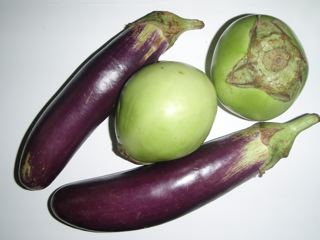Weeds
Grasses
Sedges
Broadleaf
Diseases
Fungal
Bacterial
Viral
Agro-ecology
Eggplants should not be planted after tomato, pepper, potato,
or other solanaceous crops to prevent a recurrence of the same pests and disease pathogens. Rotate eggplants with other crops. Verticillium wilt is controlled by crop rotation and planting crops that are not susceptible to wilt (Lindgren, 1982). Planting eggplant after rice reduces the incidence of bacterial wilt and nematodes. Proper seed selection and treatment and planting in well drained soil reduce seed rot and damping-off (Chen; Li; Kalb, 2001).
Row or fine mesh covers also help reduce pest attack. However, during the reproductive stage, hand-pollination of flowers is necessary (Lindgren, 1982).
Plastic as ground cover tends to improve the yield as it warms the soil, conserves moisture, and controls weeds (Lindgren, 1982). Place plastic mulch in the soil beds before transplanting and make holes where seedlings are transplanted. Organic mulches are placed after transplanting to cool off soil temperature (Chen; Li; Kalb, 2001).
Apply farm manure and
neem cake as basal fertilizers (Sridhar; et. al., 2002: p 16). Watering newly transplanted plants well with seaweed extract or with compost tea will give the seedlings a good start. To prepare your own compost tea, mix 1 part of compost with 6 parts of water. Leave the mixture for one week. Strain and spray on seedlings to control fungal pathogens and prevent infection (Ellis;Bradley, 1996: pp. 425-427)
Forty days after transplanting, sidedressing with groundnut cake is recommended. Also at this period, remove three nodes at the tips of the plants to improve branching and to increase the number of fruits (Sridhar; et. al., 2002: pp. 16-17).
Further information
Breeding work on disease and pest resistance in eggplant has been limited because of the lack of desirable traits in the eggplant genome or sexual incompatibility with resistant, related wild species, although pure-line selection has been carried out in the USA, India, Thailand, Taiwan (AVRDC), Italy, the
Philippines, and Indonesia.
Long purple and Bulakena are Batangas (Philippines) cultivars which are resistant to bacterial wilt, have very few seeds, and are high yielding (PCARRD, 1999). The Kopek variety of Java has the same characteristics (CABI, 2000; CABI, 2004).
External links
References
- CABI. (2000): Crop protection compendium. Global module, 2nd edition. CABI Publishing, Wallingford, UK.
- CABI. (2004): Crop protection compendium. 2004 Edition. CAB International Publishing. Wallingford, UK.
- Chen, N.; Li, H.; Kalb, T. (2001): Suggested cultural practices for eggplant. AVRDC Training Guide. Asian Vegetable and Research Development Center. Shanhua, Taiwan.
- Ellis, B.; Bradley, F. (1996): The organic gardener's handbook of natural insect and disease control. Rodale Press. Emmaus, Pennsylvania.
- PCARRD. (1999): Eggplant production guide. PCARRD. Laguna, Philippines.
- Sridhar, S.; Arumugasamy, S.; Saraswathy, H.; Vijayalakshmi, K. (2002): Organic vegetable gardening. Center for Indian Knowledge Systems. Chennai.

